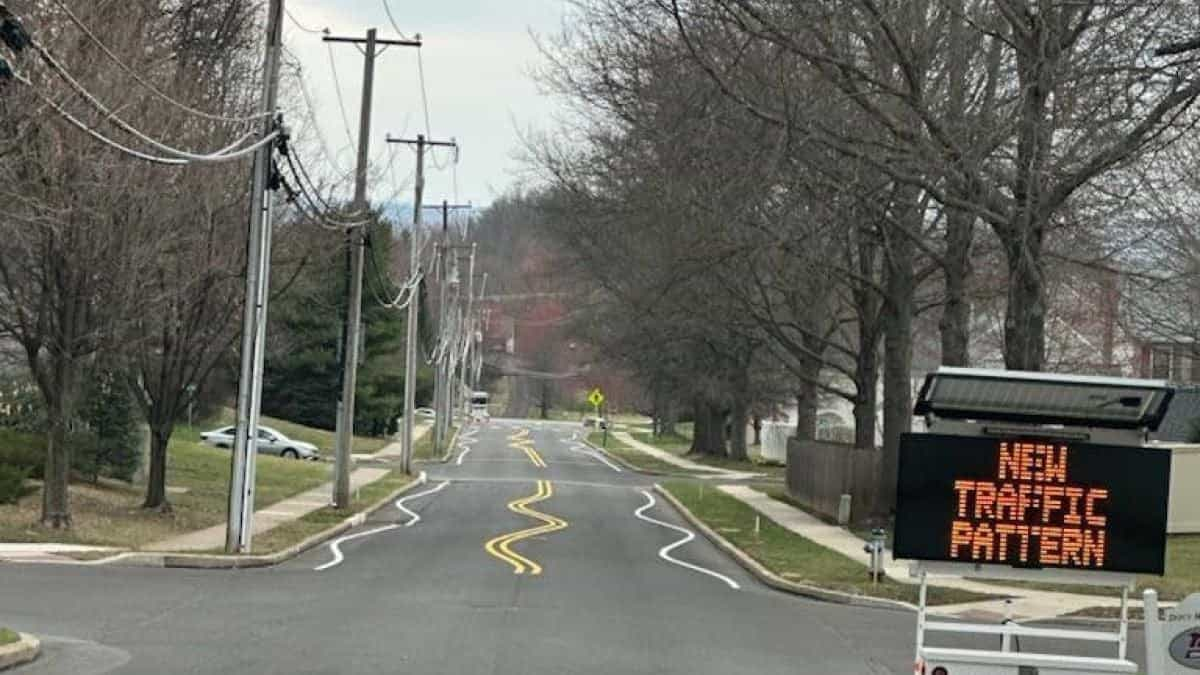Show table of content Hide table of content
The residents of Montgomery city recently woke up to an unexpected sight on their local roads – wavy, serpentine lines replacing the traditional straight lane markings. This unusual road design has sparked significant controversy among locals who question both its effectiveness and necessity as a traffic calming measure.
Sinuous road markings appear overnight in Montgomery
Montgomery city officials implemented these winding road lines as part of a new initiative to combat speeding in areas where excessive velocity has been a persistent problem. The curvy white lines create an optical illusion that encourages drivers to slow down while navigating the seemingly narrowing path.
When the city announced this change on their Facebook page, many residents initially assumed it was an April Fool’s joke. The municipality quickly clarified that this was a genuine traffic safety measure designed to protect road users by naturally encouraging slower speeds without requiring physical obstacles.
Life This TikToker buys a used van and realizes it has a hidden surveillance device.
Similar traffic calming experiments have been tested in other cities globally with varying degrees of success. While some urban planners praise these psychological approaches to speed reduction, critics argue they can create confusion. In some communities, dedicated lanes for smartphone-distracted pedestrians have been another controversial traffic innovation.
The wavy lines represent a departure from traditional traffic management techniques like speed bumps, raised crosswalks, or digital speed displays. Unlike these conventional methods, the winding lines attempt to influence driver behavior subtly through visual cues rather than physical deterrents.
Residents express frustration over the new road design
Local reaction to the snake-like road markings has been overwhelmingly negative. Montgomery residents have voiced their concerns through social media, community meetings, and direct complaints to city officials.
Mike DiLorenzo, a long-time Montgomery resident, expressed his frustration: “This isn’t the right solution. There were other options they should have considered instead.” His sentiment was echoed by William King, another local who suggested: “Speed bumps would have been much more effective at slowing down drivers on this street.”
Life Say goodbye to flat and deep plates, here’s the new dinnerware trend for 2025.
The unusual appearance of the road has become a source of mockery among some community members. Several residents jokingly compared the street to a roller coaster, while others suggested the road painting crew must have been intoxicated during installation. One resident quipped to the New York Post: “If you drive like that on any other street, police will think you’re drunk!”
This creative approach to traffic management reminds us that even well-intentioned changes can face resistance when they dramatically alter familiar environments. Similarly, some towns have banned modern devices entirely for specific reasons, creating equally passionate debates about public space management.
Traffic safety innovations face implementation challenges
The controversy in Montgomery highlights the broader challenges municipalities face when implementing innovative traffic safety measures. Road design significantly impacts not just safety but also community aesthetics and daily driving experience.
Traffic engineers must consider multiple factors when developing speed reduction strategies. Physical measures like speed bumps can damage vehicles and create noise pollution, while speed cameras might feel intrusive to residents. The winding lines represent an attempt at finding a middle ground – a non-invasive solution that achieves the desired effect without creating physical obstacles.
However, unexpected changes to familiar environments can trigger resistance, much like how tourists visiting unfamiliar cities like Cologne during Christmas might feel disoriented by the different traffic patterns and pedestrian zones.
The importance of proper consultation before implementing such changes cannot be overstated. Many Montgomery residents felt blindsided by the sudden appearance of the winding lines, contributing to their negative reaction. This resembles situations where unexpected actions cause disruption, like when competition tensions lead to unforeseen consequences – proper protocols prevent unwelcome surprises.
Future of urban traffic management solutions
The Montgomery experiment raises important questions about the evolution of traffic calming measures in urban environments. Will psychological approaches like visual illusions become more common, or will cities return to traditional physical deterrents?
Research suggests effective traffic management requires a multifaceted approach. The most successful strategies combine physical elements, visual cues, community education, and consistent enforcement. Just as some household problems require regular attention, traffic safety demands ongoing maintenance and reassessment.
Life Everyone had this toy in the ’90s, and it now sells for over $3,000.
Cities increasingly face competing priorities – keeping streets safe while maintaining efficient traffic flow and respecting resident preferences. The Montgomery winding lines represent one city’s attempt to balance these complex factors.
Transportation experts recommend community involvement when implementing novel traffic solutions. When residents participate in decision-making, they develop greater understanding and acceptance of changes, even unconventional ones. This collaborative approach resembles how simple solutions to common problems often emerge from sharing knowledge and experiences.
As Montgomery evaluates the effectiveness of their winding road lines, other municipalities will be watching closely. The ultimate measure of success will be whether speeding decreases on the targeted streets, regardless of initial public reaction. Transportation officials have promised to collect data on traffic speeds and incidents to determine if the visual deterrent achieves its intended purpose.


